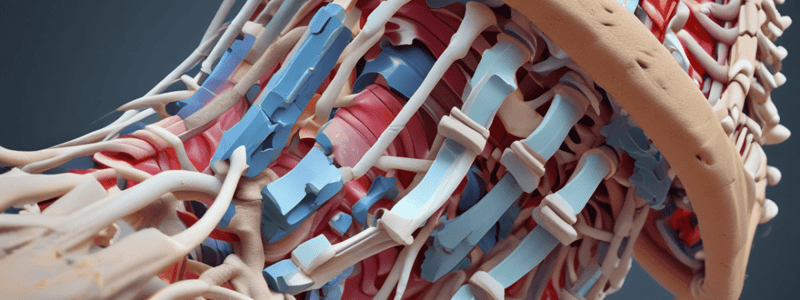Podcast
Questions and Answers
Shear force causes each vertebra to move only anteriorly or posteriorly.
Shear force causes each vertebra to move only anteriorly or posteriorly.
False (B)
Apophyseal joints in the lumbar spine resist all of the shear force.
Apophyseal joints in the lumbar spine resist all of the shear force.
False (B)
The cumulative effect of elementary movements in the spine is insignificant.
The cumulative effect of elementary movements in the spine is insignificant.
False (B)
Rotation of the spine causes the intervertebral disc to become thicker anteriorly.
Rotation of the spine causes the intervertebral disc to become thicker anteriorly.
Flexion of the upper vertebra compresses the posterior side of the annulus fibrosus.
Flexion of the upper vertebra compresses the posterior side of the annulus fibrosus.
During flexion, load is transferred from the intervertebral discs to the apophyseal joints.
During flexion, load is transferred from the intervertebral discs to the apophyseal joints.
The ligamentum flavum limits extension of the spine.
The ligamentum flavum limits extension of the spine.
Lateral flexion increases the size of the intervertebral foramina.
Lateral flexion increases the size of the intervertebral foramina.
During extension, the nucleus of the disc is pushed posteriorly, towards neural tissue.
During extension, the nucleus of the disc is pushed posteriorly, towards neural tissue.
Extension decreases the size of the intervertebral foramina opening.
Extension decreases the size of the intervertebral foramina opening.
During lateral flexion, the upper vertebra is raised on the concave side.
During lateral flexion, the upper vertebra is raised on the concave side.
The articular processes of the upper and lower vertebrae glide apart during extension.
The articular processes of the upper and lower vertebrae glide apart during extension.
During lateral flexion, the contralateral intertransverse ligament slackens.
During lateral flexion, the contralateral intertransverse ligament slackens.
Extension causes relaxation of the posterior longitudinal ligament.
Extension causes relaxation of the posterior longitudinal ligament.
The anterior fibers of the annulus and the anterior longitudinal ligament are stretched during flexion.
The anterior fibers of the annulus and the anterior longitudinal ligament are stretched during flexion.
Lateral flexion causes stretching of the ipsilateral ligamenta flava and contralateral capsular ligament of the facet joint.
Lateral flexion causes stretching of the ipsilateral ligamenta flava and contralateral capsular ligament of the facet joint.
The direction of rotation that accompanies lateral flexion is consistent across all regions of the spine.
The direction of rotation that accompanies lateral flexion is consistent across all regions of the spine.
The risk of injury is highest when rotational forces are combined with compressive forces only.
The risk of injury is highest when rotational forces are combined with compressive forces only.
The ligamentum nuchae limits lateral flexion of the spine.
The ligamentum nuchae limits lateral flexion of the spine.
The anterior annulus fibrosus restricts extension of the spine.
The anterior annulus fibrosus restricts extension of the spine.
The intertransverse ligament limits axial rotation in the lumbar region.
The intertransverse ligament limits axial rotation in the lumbar region.
The alar ligament is involved in limiting lateral flexion in the thoracic region.
The alar ligament is involved in limiting lateral flexion in the thoracic region.
The posterior longitudinal ligament restricts lateral flexion of the spine.
The posterior longitudinal ligament restricts lateral flexion of the spine.
The capsule of the apophyseal joints plays a role in limiting lateral flexion.
The capsule of the apophyseal joints plays a role in limiting lateral flexion.
Flashcards are hidden until you start studying




